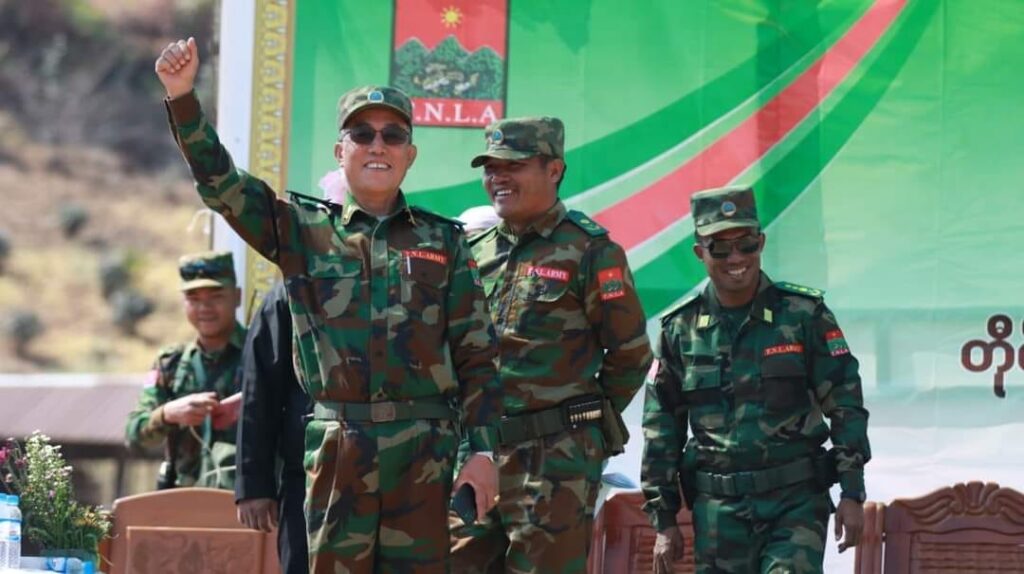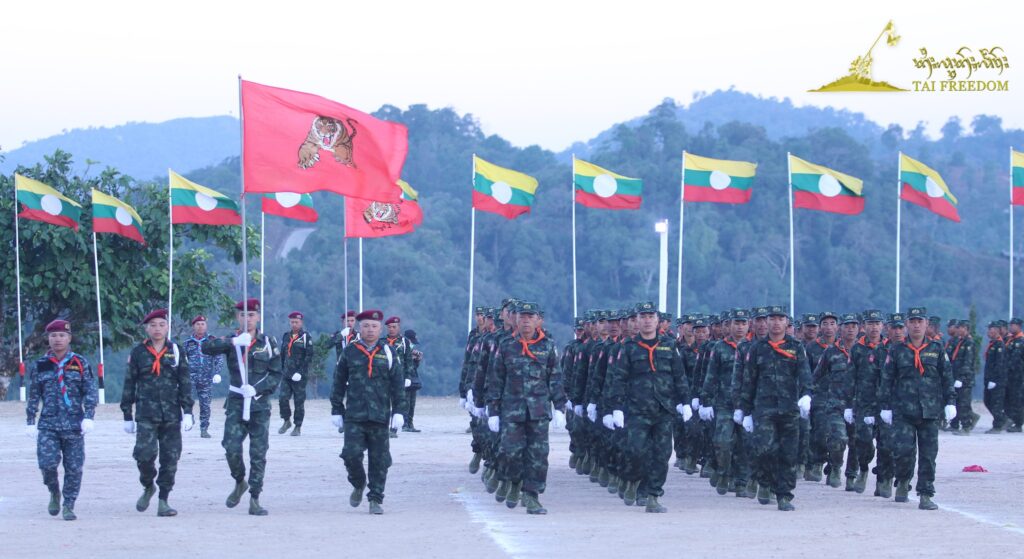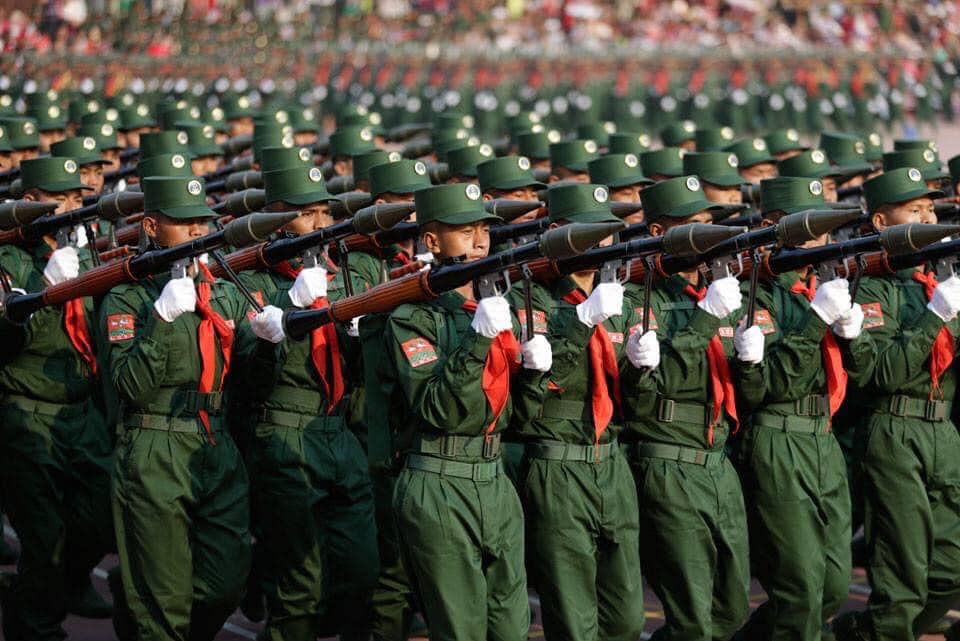Immediately after the military coup d’etat in February 2021 by the military junta headed by General Min Aung Hlaing massive civil unrest erupted followed by mass uprising all over the country. By the end of March, the military, which called itself State Administration Council (SAC), started using excessive force against demonstrators, which killed at least 320 people within a few weeks of unrest.
.
The mass exodus into the ethnic armed organizations’ (EAOs) followed and eventually National Unity Government (NUG) and its armed wing People’s Defence Force (PDF) were formed.
Since then, the NUG/PDF and EAOs loose alliance involving the ethnic armed forces in Chin, Kachin, Karenni and Karen states has been in existence.
But the Arakan, Mon and Shan states are not part of the mentioned loose alliance, as the Arakan Army (AA) in Arakan State has its own agenda although it is sympathetic to the Bamar instilled Spring Revolution to uproot the military dictatorship.
Somewhat similarly, the NMSP in Mon State is also keen to cut a deal with the SAC as the best way to go about, although the Mon population may have other considerations.
But the EAOs in Shan State are completely different as they are occupied with inter-ethnic, or rather inter-EAO conflict, mostly fuelled by group survival instinct and territorial expansion and control urge, including sometimes having to act as proxies, willingly or unwillingly, for the giant regional power to further it’s national interest.
The Shan State EAOs
Generally speaking, the EAOs in Shan State can be roughly divided into two groups, of which they are members of the Federal Political Negotiation and Consultative Committee (FPNCC) and Nationwide Ceasefire Agreement – Signatory EAOs (NCA-S-EAOs).

FPNCC seven-member alliance formed in 2017 is made up of United League of Arakan/Arakan Army (ULA/AA), Kachin Independence Organization/Army (KIO/KIA), Myanmar National Truth and Justice Party/Myanmar National Democratic Alliance Army (MNTJP/MNDAA), Peace and Solidarity Committee /National Democratic Alliance Army (PSC/NDAA), Palaung State Liberation Front/Ta’ang National Liberation Army (PSLF/TNLA), Shan State Progress Party/Shan State Army-North (SSPP/SSA-N), and United Wa State Party/Army (UWSP/UWSA). All are local groups stationed in Shan State, except for the KIA and AA which also have their other main operational areas in Kachin State and Arakan (Rakhine) State respectively.
The UWSA, MNDAA and NDAA stem from the defunct Communist Party Burma (CPB), when in 1989 it disintegrated due to the mutiny of the non-Bamar ethnic forces.
The SSPP was allied to the CPB before it was defunct and later became the UWSA ally even before the formation of FPNCC. Two of its known leaders, Sao Hso Ten and Sao Khun Seng are former CPB members and they are still serving with the SSPP.

The TNLA was originally founded as the Palaung State Liberation Organization/Army (PSLO/A). It signed ceasefire agreement with the government in 1991 and disarmed in 2005. Following the dissolution the Ta’ang leaders Tar Aik Bong and Tar Bone Kyaw founded the TNLA alongside the Palaung State Liberation (PSLF) to continue the struggle. Before the Ta’ang or Palaung resistance was formed in the mid-1960s, there used to be a Palaung brigade under the Shan State Army forerunner of the SSPP. After 2005 the KIA helped rebuilt the TNLA forces and now is closely allied to the UWSA.
AA was formed in 2009 with the help of KIA and it still has its headquarters in Kachin State. Its troops operate in northern Shan State and Kachin State in the capacity of an ally although no exact number of troops were made public. AA said there were some 5,000 to 6,000 troops outside the Arakan State serving with the allies.
The KIA was formed on 5 February 1961, together with Kachin Independence Council (KIC) near Kutkai, northern Shan State. The ideology is Kachin nationalism and federalism and not affiliated with left wing groups even though it is now FPNCC member.
NCA-S-EAOs which have ten members only three are from Shan State. They are RCSS, Pa-O National Liberation Organization (PNLO), and Lahu Democratic Union (LDU) which has no armed soldier.

The RCSS founded in 1996 came from Mong Tai Army (MTA), which was dissolved in 1989. The MTA was made up of Shan United Revolutionary Army (SURA) led by Mo Heng and Shan United Army (SUA) led by Khun Sa in 1985. RCSS ideology is Shan nationalism and federalism.
The PNLO a NCA signatory, was established in 2009 with its headquarters in Laybwer camp, Southern Shan State. It is active in Shan State’s Hsihseng, Hopong, Namsang, Langkho, and Mawkmai. It has over 400 soldiers and led by its Chairman – Maj. Gen. Khun Thurein. Its ideology is Pa-O nationalism and federalism.
Rational
Generally speaking, many Burma watchers, observers and experts are of the opinion that only the coalition or alliance of all ethnic-democratic forces will be able to force the SAC out of power, or at least swing it to sit down for a negotiated surrender settlement.
In line with this thinking some advancements have been made, although it is still a long way to achieve a desired result as aspired.
For example, on October 2021, the NUG officially announced the formation of the Central Command and Coordination Committee (C3C) including the NUG, Kachin Independence Army (KIA), Karenni National Progressive Party (KNPP), Chin National Front (CNF), and All Burma Students’ Democratic Front (ABSDF). The NUG also formed another command structure, the Joint Command and Coordination (J2C), with the Karen National Union (KNU), which is not a member of the C3C, according to Ye Myo Hein in his report of January 18, 2023, published by The Henry L. Stimson Center.
Obstacles
The main obstacle to realize the comprehensive, ethnic-democratic alliance solidarity, especially in Shan State, is the never-ending inter-EAO conflict, although other multidimensional factors will also have to be taken into account.
They are group survival instinct and territorial expansion urge; seeing the civil war as Bamar-Bamar, NUG-SAC conflict; not interested to find identity politics solution within Shan State; and desire to keep the status quo as it is beneficial for the powerful EAOs, among others.
Inter-EAO conflict, together with territorial expansion urge, have always been a way of life in Shan State political arena. But the biggest actors are the Shan and Wa resistance armies. For example, in 1996 the UWSA occupied two separate swathes of territory north and south of Kengtung, with the help of Burmese military. This is the standing evidence and the case in point of inter-ethnic animosity war-like attitude embedded in the mindset of EAO adversaries.

In the same vein, the RCSS intrusion into SSPP and TNLA claimed areas in northern Shan State in 2015 but ended in 2021, when it was pushed back by the combined force of TNLA, SSPP and UWSA with overwhelming fire power, also falls into the same category of territorial expansion urge that comes with the inter-EAO conflict. It is believed that China also wanted the RCSS out of northern Shan State and indirect directive have been given to evict the latter.
Identically, the TNLA trying to include all of Namhsan and Mantong townships, parts of Namhkam, Mongyai, Tangyan, Kyaukme, Hsipaw, Lashio and Namtu townships in northern Shan State, and Mogok Township in northern Mandalay Region is squarely within the category of territorial expansion, at the expense of Shan majority population.

The PNLO and RCSS on-and-off clashes for years and even recently are also of the same nature.
Most Shan EAOs see the ongoing civil war as NUG-SAC, Bamar-Bamar conflict and won’t bother to join the Spring Revolution or jump into the same boat with the NUG.
Most importantly, the squabbling Shan State EAOs, particularly the Wa, Palaung, and Pa-O, are not interested to resolve the identity politics and cling to narrow ethnonationalism demanding a neatly demarcated ethnic states at union-level, which is impossible and a recipe for unending inter-ethnic conflict. Because this is hardly feasible as the different ethnic habitation pattern is overlapping even within a village, needless to say the whole Shan State. In fact, agreeing upon a common Shan national identity may be the way out, like on the eve of Burma’s independence in 1947, when Shan National Day, Flag and National Anthem were agreed upon by all stakeholders.
Notably it is important to take into account that the documentation and birth of the Shan nation is signed by a Palaung Tawngpeng Saohpa or Sawbwa Hkhun Pan Sing, who was the president of Council of Shan State Saohpa, on 11 February 1947. One day after it, on 12 February 1947 the historical Panglong Agreement was signed between the then Chin Hill, Kachin Hill, Federated Shan States and Burma Proper, also known as Ministerial Burma, all still under the British rule.
The powerful EAOs, which are also wealthy due to the ceasefire capitalism, are happy to maintain status quo, as they prosper and benefit from such arrangement. The glittering cities of Panghsang and Mongla are convincing examples, so the rational maybe why bother to fight when you can stay at ease and have all the time to bargain for more political say and fulfilment of upgraded administrative status.
Perspective
In sum, under such circumstances it is fair to conclude that Shan State will stay out of the mainstream Spring Revolution fray for the foreseeable future, basically because of the inter-ethnic conflict and lack of cohesion to act on common political goals and agendas within Shan State and as an extension, the whole country.
Surely, some of the EAO will be sympathetic to the Spring Revolution enablers like the NUG and its allies. But there is very little likelihood they will opt for armed confrontation with the SAC anytime soon.



